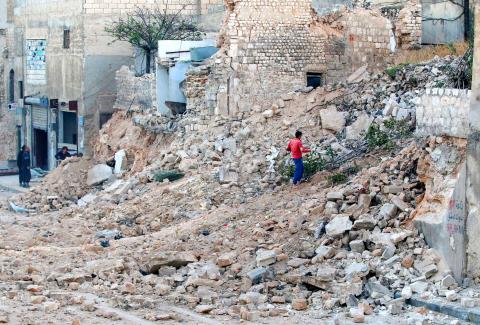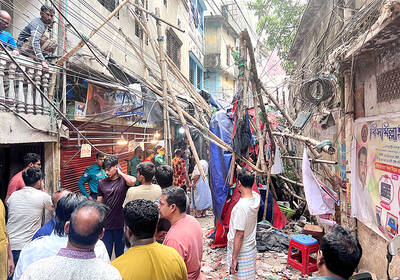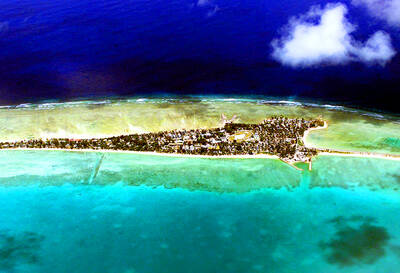Syrian state media said government forces on Saturday captured the largest rebel-held district of Aleppo, in what would be a major breakthrough in its offensive to retake the entire second city.
Masaken Hanano was the first district the rebels took in the summer of 2012 in a move that divided Aleppo into an eastern area held by the insurgents and a western district controlled by government forces.
Since then, more than 250,000 civilians have been trapped under government siege for months in the rebel-held east, with dwindling food and fuel supplies.

Photo: Reuters
The capture of Masaken Hanano in northeastern Aleppo is part of a major government offensive in its 12th day that could isolate that part of the city from rebel-held areas in the south.
Since Nov. 15, regime bombardment of eastern Aleppo has killed 212 civilians, including 27 children, according to the UK-based Syrian Observatory for Human Rights.
Regime forces had been advancing inside Masaken Hanano for several days, and on Friday state television said they were progressing “from three axes.”
On Saturday, the state broadcaster and the official SANA news agency said Syrian President Bashar al-Assad’s armed forces, backed by their allies, had taken “full control” of the district.
“The armed forces retook full control of Masaken Hanano after having put an end to the presence of terrorists there,” the state broadcaster said, referring to the rebels.
SANA said government forces also recaptured the area around the district and “army engineers are clearing it of bombs and explosives planted by the terrorists in the streets and squares.”
However, Yasser al-Youssef, from the rebel group Nureddin al-Zinki, said fighting was still under way on the southern edges of Masaken Hanano, which he called a district of “strategic importance.”
Al-Youssef said that if regime forces can advance to the adjacent neighborhood of Sakhur, then eastern Aleppo will be split in two.
The observatory also said on late Saturday that regime forces completely controlled Masaken Hanano and had begun an assault on Sakhur and nearby al-Haidariya.
The latest regime push comes after days of intense bombardment on the rebel-held east, which was pounded with airstrikes, shells and barrel bombs.
The escalation has terrified residents, and several families have fled to areas in southeastern Aleppo which have been relatively calm.
On Saturday, a reporter in one of those districts saw four families, without belongings, arrive on foot seeking shelter.
“In Hanano, for the past three days, they haven’t been able to set foot outside because of the intense bombardment,” said Abu Fadel, who helped them find lodgings.
“They left on foot because they had no other means of transport. At first they were afraid, but when they saw many people around and that there was no bombardment they were reassured,” he said.
Damascus says east Aleppo residents and surrendering fighters are free to leave, but accuses the rebels of using civilians as “human shields.”
Before the army said it had captured Masaken Hanano, dozens of families fled from Sakhur and al-Haidariya districts and headed further south, the observatory said.
They took flight as regime forces pounded eastern Aleppo with air raids, including Sakhur, killing at least 11 civilians, it said.
The UN has a plan to deliver aid to Aleppo and evacuate the sick and wounded, which rebel factions have approved, but which Damascus has yet to agree. Guarantees are also needed from regime ally Russia.
Also on Saturday, a string of explosions rocked a munitions storage site in northeastern Syria used by the US-led coalition battling the Islamic State group, the observatory and a local official said.
Contacted by reporters, the coalition said there had been “no reports of explosions” at the site.

DISASTER: The Bangladesh Meteorological Department recorded a magnitude 5.7 and tremors reached as far as Kolkata, India, more than 300km away from the epicenter A powerful earthquake struck Bangladesh yesterday outside the crowded capital, Dhaka, killing at least five people and injuring about a hundred, the government said. The magnitude 5.5 quake struck at 10:38am near Narsingdi, Bangladesh, about 33km from Dhaka, the US Geological Survey (USGS) said. The earthquake sparked fear and chaos with many in the Muslim-majority nation of 170 million people at home on their day off. AFP reporters in Dhaka said they saw people weeping in the streets while others appeared shocked. Bangladesh Interim Leader Muhammad Yunus expressed his “deep shock and sorrow over the news of casualties in various districts.” At least five people,

ON THE LAM: The Brazilian Supreme Court said that the former president tried to burn his ankle monitor off as part of an attempt to orchestrate his escape from Brazil Former Brazilian president Jair Bolsonaro — under house arrest while he appeals a conviction for a foiled coup attempt — was taken into custody on Saturday after the Brazilian Supreme Court deemed him a high flight risk. The court said the far-right firebrand — who was sentenced to 27 years in prison over a scheme to stop Brazilian President Luiz Inacio Lula da Silva from taking office after the 2022 elections — had attempted to disable his ankle monitor to flee. Supreme Court judge Alexandre de Moraes said Bolsonaro’s detention was a preventive measure as final appeals play out. In a video made

It is one of the world’s most famous unsolved codes whose answer could sell for a fortune — but two US friends say they have already found the secret hidden by Kryptos. The S-shaped copper sculpture has baffled cryptography enthusiasts since its 1990 installation on the grounds of the CIA headquarters in Virginia, with three of its four messages deciphered so far. Yet K4, the final passage, has kept codebreakers scratching their heads. Sculptor Jim Sanborn, 80, has been so overwhelmed by guesses that he started charging US$50 for each response. Sanborn in August announced he would auction the 97-character solution to K4

SHOW OF FORCE: The US has held nine multilateral drills near Guam in the past four months, which Australia said was important to deter coercion in the region Five Chinese research vessels, including ships used for space and missile tracking and underwater mapping, were active in the northwest Pacific last month, as the US stepped up military exercises, data compiled by a Guam-based group shows. Rapid militarization in the northern Pacific gets insufficient attention, the Pacific Center for Island Security said, adding that it makes island populations a potential target in any great-power conflict. “If you look at the number of US and bilateral and multilateral exercises, there is a lot of activity,” Leland Bettis, the director of the group that seeks to flag regional security risks, said in an